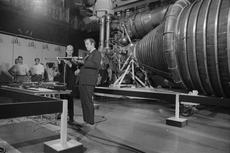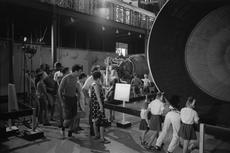 Although his predecessors had approached television with wariness and caution, Smithsonian Secretary S. Dillon Ripley was more pragmatic, optimistic, and enthusiastic. Ripley recognized television's potential not only for "everyday learning" but also for showcasing Smithsonian research and collections. During Ripley's tenure, the Smithsonian made one giant leap forward in using new communications technologies, developing a number of documentary specials with famous Hollywood producer David L. Wolper and collaborating on the successful public television series Smithsonian World.
Although his predecessors had approached television with wariness and caution, Smithsonian Secretary S. Dillon Ripley was more pragmatic, optimistic, and enthusiastic. Ripley recognized television's potential not only for "everyday learning" but also for showcasing Smithsonian research and collections. During Ripley's tenure, the Smithsonian made one giant leap forward in using new communications technologies, developing a number of documentary specials with famous Hollywood producer David L. Wolper and collaborating on the successful public television series Smithsonian World.
 It was in the Ripley spirit that the Smithsonian invited the public to observe while NBC and CBS telecast from the Arts & Industries Building all day and throughout the night of July 20, 1969. Visitors and broadcasters joined together in a once-in-a-universe celebration when Neil Armstrong stepped onto the Moon.
It was in the Ripley spirit that the Smithsonian invited the public to observe while NBC and CBS telecast from the Arts & Industries Building all day and throughout the night of July 20, 1969. Visitors and broadcasters joined together in a once-in-a-universe celebration when Neil Armstrong stepped onto the Moon.
 That event epitomized television's promotion of "actuality," encouraging millions of viewers to participate in an event by watching it on a screen. By the late 1960s, people had come to find such experiences routine. From ninth-inning home runs to
That event epitomized television's promotion of "actuality," encouraging millions of viewers to participate in an event by watching it on a screen. By the late 1960s, people had come to find such experiences routine. From ninth-inning home runs to
dropped football passes, from disruptions at political conventions to accused criminals entering a courthouse, the events at mid-century passed before our eyes via our television screens. We watched, gasped, sighed, laughed, and cried in the company of friends and family and, thanks to international telecommunications satellites, reacted simultaneously with millions of strangers.

Reality, broadcasting, illusion, and humanity combined to create what Frederick Durant, Smithsonian assistant director of astronautics, called "instant history." Watching events on television had become the next best thing (or in the case of stepping onto the Moon, the only alternative for most of us) to being there.
If you were one of the 17,000 visitors that visited the Smithsonian to celebrate the moon landing, let us know by leaving a comment below.
Related Resources
- The Apollo Program, National Air and Space Museum
- Apollo to the Moon, online exhibition, National Air and Space Museum
- Neil Armstrong, 1969, by Louis Glanzman, National Portrait Gallery
Produced by the Smithsonian Institution Archives. For copyright questions, please see the Terms of Use.

Leave a Comment